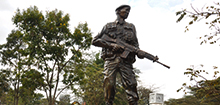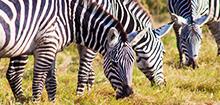Date Published:
Kenya’s ministry of Tourism and Wildlife is seeking a budgetary allocation of fifteen billion shillings from the National Treasury to enable it compensate families of people killed by wildlife, those injured or whose property has been destroyed by the animals.
The ministry’s Principal Secretary, Dr. Margaret Mwakima, who represented Cabinet Secretary, Mr. Najib Balala during this year’s World Elephant Day celebrations in Meru town called for patience among those affected, while at the same time urging members of both the National Assembly and Senate to support the budgetary allocation sought by her ministry.
Other than the compensation funds sought, Dr. Mwakima stated that the ministry is also exploring ways of establishing a National Insurance Compensation Scheme, saying that they are working closely with National Treasury on modalities of executing the initiative.
“As a ministry, we have launched a Tourism blue print and National Wildlife Management Strategy to resolve the perennial human-wildlife conflict”, the PS said, adding modalities of compensating people affected by the problem is a major strategic focus for the government.
The celebrations were attended by key National and County government officials, including these from Kenya Wildlife Service led by the chairman Board of Trustees, Dr. John Waithaka, acting KWS Directing General, Prof. Charles Musyoki and Kenya Forest Service Board chairman, Mr. Peter Kinyua. The County government was represented by Meru Governor Kiraitu Murungi, his deputy Titus Ntuchiu, among a host of other county government officials.
Dr. Mwakima impressed upon National and County government officials to come up with joint policies on how to manage wildlife dispersal areas and corridors. This, she said, would end the tendency to work in silos, which is a recipe for conflict between the two levels of government.
Dr. Waithaka amplified this year’s World Elephant Day theme, “Elephants and people: Co-existence is possible”. “Human-wildlife conflict is actually conflict amongst people because they are the ones who are encroaching on wildlife habitats”, the chairman asserted.
He said the effects of land-use change and burgeoning human populations lead to shrinking habitats, giving way to human-wildlife conflict, further rendering the elephant more vulnerable regardless of its size and strength. “We must resist the extinction of any more of our wildlife, by stopping habitat fragmentation, blockage of corridors, poaching, consumer demand for ivory, and allocate resources to protect natural habitat in areas where elephants and other wildlife can thrive now and in the future”, the chairman said.
Prof. Musyoki said national elephant population in the country stood at 33, 948 as at end of the year 2017 in a range area of 139,344 Km2, noting this represents a 2.25% annual increase since 1989. He attributed population and range increase to establishment of community conservancies in known elephant range areas and tolerance by communities living with elephants.
He said due to various efforts to combat poaching nationally, there has been spatial shifts in poaching across the all elephant range areas of Tsavo, Samburu-Laikipia, Marsabit, Amboseli, Meru, Mara and forest ecosystems like Aberdare, Mt. Kenya and Mau, where very minimal poaching incidents were reported in the year 2017.
The acting Director General said KWS in conjunction with other relevant agencies, both local and international, has taken several measures to protect and conserve the elephant, including:
- Enhanced inter departmental collaboration in intelligence information gathering and sharing among key government departments, and the inclusion of elephant poaching and illegal ivory trade into the Agenda of the Nation Security Council
- Cross-border collaboration in information sharing and deployment of wildlife security patrols,
- Enhanced capacity of law enforcement and wildlife protection agencies
- Global public awareness campaigns especially to the consumer countries against poaching and illegal trade in ivory,
- Improved engagement of communities living with elephants as active partners to elephant conservation through supporting community efforts to manage and benefit from wildlife
- Establishment of a DNA and Forensic Laboratory that has helped identify origin of seized ivory, and isotopic analysis that provide admissible evidence in courts of law
- Improved focus on species specific challenges through development and implementation of species action plans.





